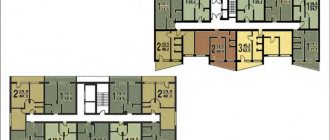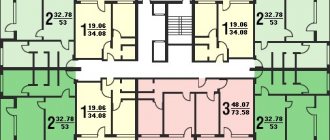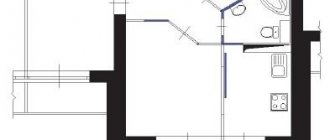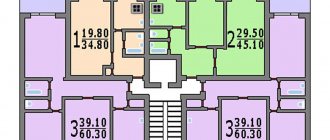Any changes in the size of individual rooms or the transfer of interior partitions in the apartment are recognized as redevelopment, the implementation of which is impossible without obtaining prior permission.
Today, apartment owners have gone much further and began to divide their property into several separate apartments. Such manipulations with housing require compliance with a special approval and legalization procedure.
Dividing an apartment into two apartments is more common in Moscow, the Moscow region and St. Petersburg due to the high demand for rental housing in these cities.
It is much easier and more profitable to rent out several small separate apartments than one consisting of three or four rooms.
We will discuss in detail below which apartments can be legally divided and what needs to be done for this.
What is the essence and necessity of separating apartments?
Dividing one apartment into two separate ones may be necessary in various life situations . Some of the owners are trying to use their property more profitably as an investment object, others cannot come to an agreement with the second owner of the property and are trying to distance themselves as much as possible from their neighbor.
Before answering the question: how to divide an apartment into two apartments, you need to understand the motives for such a desire. Despite the fact that most often citizens seek to combine several apartments into one, opposite situations also occur.
The division of an apartment into several separate real estate units usually occurs in the following situations:
- divorce of spouses who were unable to agree on the division of jointly acquired property;
- division of property by heirs who do not want to jointly own one property;
- allocation of a separate living space for a grown child;
- the desire to profitably sell real estate or rent it out to several tenants at once.
Both single apartments and those that in the past were combined from two separate residential premises are subject to division into two apartments.
How to turn a two-room apartment into two studios? About the same as from a one-room studio to two. Distinctive features in the procedure for approving redevelopments of this nature apply only to those apartments that were initially combined and those that were initially considered unified.
But the larger the apartment, the more difficult it is to legally divide it. This is due to the fact that for each new residential property the law establishes special rules, violation of which will become an obstacle to registration of changes.
Joint ownership of a house
Any citizen can receive a house in joint ownership in the following situations:
- The family privatizes the property and several of its members are included in the ownership certificate.
- The house was purchased jointly with other persons.
- The house was inherited by several heirs.
- Several people want to buy a house that is in shared ownership.
- The property was donated to several people.
- The property was purchased using the joint funds of the spouses during marriage.
All persons can own and use joint property without restrictions. However, such property can be disposed of only with the consent of all co-owners.
This means that in order to carry out any transaction for which the law requires a written form, it is necessary to obtain written permission from all persons who own part of the real estate.
Regulatory Requirements
Is it possible to make two apartments out of one and legitimize them, we have decided. It is quite possible to do this, the main thing is to comply with all regulations and standards.
So, how can you turn an apartment into two apartments? For 2021, the following rules apply, which must be observed when changing the living space of the premises:
- Each newly created housing must have a separate bathroom, kitchen and a separate exit to the landing.
- All changes must comply with fire safety rules and sanitary and hygienic requirements.
- Any changes must be agreed upon with the neighbors of the apartment building.
- The kitchen should not be located above the living rooms of the neighbors below.
- You cannot install a gas stove in a kitchen niche, which is located in a one-room apartment.
The space for a new bathroom in a divided apartment must first be transferred from residential status to non-residential status.
It is actually difficult to comply with all these requirements . Therefore, not every homeowner makes such radical changes. The requirement to prohibit the placement of a wet zone under the living rooms of neighbors makes such a layout possible only on the first floors of apartment buildings.
Building a separate entrance for each new apartment seems like an impossible requirement . However, the law gives him an alternative. It is possible to organize a separate vestibule in a divided apartment for several separate residential properties. But you need to understand that the vestibule significantly reduces the part of the living space that could count towards the area of one of the apartments.
How to turn a one-room apartment into two apartments? Do not forget that for this the minimum values for residential premises must be met.
Thus, according to SNiP 31-01-2003 “Residential multi-apartment buildings”, the area of a living room in a one-room apartment must be at least 14 square meters, in a two-room apartment - 16 square meters.
The size of a bedroom in a residential apartment for one person must be at least 9 square meters, for two people - 10 square meters; kitchens – 8 square meters.
Which apartments cannot be divided?
When wondering how to make two studios out of a one-room apartment, you need to take into account other prohibitions along with those we indicated above.
The division of an apartment is subject to a ban that relates to the following restrictions:
- Reconstruction of an apartment can lead to the destruction of load-bearing structures, deterioration of the condition of the facade of the premises, and disruptions in the operation of communications or fire safety devices.
- Dividing an apartment into two entails a deterioration in the lives of the neighbors of a multiple-family home or their protected rights.
- It is prohibited to divide an apartment in such a way that the new residential units will not have natural lighting or heating appliances.
- It is forbidden for ventilation ducts related to the kitchen, bathroom or toilet to be combined with ducts that have access to living quarters.
- In violation of other laws, regulations and standards.
You need to understand that any unauthorized changes can lead to the destruction of the house and casualties from neighbors .
That is why government agencies control such changes in residential real estate and not everyone gives permission for such innovations.
Standard plan
The layout of the 4-room Khrushchev house provides the following premises:
- two bedrooms located in the farthest zone;
- the third room is the living room, which is a passageway for these bedrooms;
- the fourth room is another bedroom, located next to the kitchen;
- the kitchen, bathroom and toilet are located next to the hallway, close to the entrance;
- At the end of the hallway next to the living room there is a wardrobe compartment.
The next historically later type of multi-story building - a 9-story panel building, "Brezhnevka" - has some differences from the "Khrushchevka". Bedrooms and living rooms, kitchen and bathroom are located approximately the same as in 4-room “Khrushchev” apartments, but differ in size.
Higher ceilings - 2.7 m (compared to 2.45-2.5 m in Khrushchev buildings), the presence of an elevator and a garbage chute made the life of the population more comfortable.
In St. Petersburg and Moscow, a renovation program has been carried out over the past few years - old “Khrushchev” buildings, many of which are considered unsafe, are subject to resettlement and dismantling. In return, construction companies, by order of federal and local authorities, will build new buildings in which the area of the rooms will increase slightly. Kitchens, bathrooms and corridors (including hallways) will become noticeably larger.
All modern amenities - from an elevator to energy-efficient life support systems - have been significantly improved in these houses.
Brick “Khrushchev” and “Brezhnevka” buildings, regardless of the number of rooms in the apartments, have less ventilation and improved sound insulation.
Division of a combined apartment
Is it possible to divide a two-level apartment into two? Yes, that's possible too . Moreover, usually two-level apartments by default are already previously combined from two separate rooms on different floors.
The difference in the division of housing will concern not horizontal changes, but vertical ones. In such apartments it is much easier to organize the location of new rooms with wet areas, since your second apartment will be located below.
Dividing an apartment that has already been combined from two separate residential properties is easier than separating separate properties.
But at the same time, it will also be necessary to take into account the following nuances:
- It is necessary to draw up a project for the ongoing redevelopment, which reflects the possibility of installing a partition and the procedure for restoring previously sealed access from the staircase.
- It is necessary to separate the previously combined electricity and water supply systems.
- Obtaining permits from authorized bodies.
- Carrying out work and legitimizing it, registering property rights to individual real estate objects.
This situation of dividing an apartment is possible if the property has one owner or the owners do not have any claims against each other. Otherwise, such issues are resolved exclusively in court.
It is much easier to divide an apartment in a low-rise building than in a building of 9 or 16 floors .
In a low-rise building, it is much easier to come to an agreement with neighbors, it is easier to equip communications and separate entrances for each resident of a new apartment.
What is common shared property?
To understand the situation, you need to define the terms. The right of common property is the right of two or more persons to independently dispose, own and use certain property. For example, a house in a village owned by several people is in common ownership. Such property may be:
- indivisible;
- prohibited from division by law;
- divisible.
There are two types of common property, according to paragraph 2 of Article 244: joint and shared. Let us explain what this is and what the difference is: in the first case, the shares of the owners’ property are not determined in advance.
Moreover, in both cases, unless otherwise established by law, agreement or other document, it is considered that the shares of all owners are equal.
How is an apartment divided?
The general algorithm for dividing real estate is as follows:
- drafting and approval of the project;
- coordination of the decision with municipal authorities;
- actual division of one apartment into two;
- inspection of work performed by inspectors and drawing up an inspection report;
- registration of new real estate objects.
Each new property will be assigned a separate number in the register. All existing real estate objects with cadastral numbers will be recorded in the Unified State Register of Real Estate.
To draw up a project, you will need to contact a specialized organization, where you will have to provide a technical passport of the apartment or a floor plan.
The housing inspection will need to be visited for approval not only with the project in hand. In addition to the project, the owner is required to submit the following set of documentation:
- statement;
- title documents for the apartment;
- conclusion of a specialized organization on the possibility of carrying out work;
- a copy of the applicant's passport;
- technical passport for the apartment;
- consent of homeowners;
- permissions from the gas service, electricians, neighbors.
The time frame for approving redevelopment in the form of an apartment division is about 2-4 months. It will take about 2 more months to obtain new title documents for real estate and record all changes in the BTI.
After the renovation work is completed, an inspector comes to visit and checks that the changes comply with the project agreements. Based on the inspection, he draws up an act in three copies, the first of which is received by the owner, the second is given to the BTI, the third is kept in the municipal authorities.
Judicial division of an apartment
If an apartment has several owners who voluntarily decide to divide the property among themselves, it is enough for them to enter into a division agreement among themselves. If desired, it can be certified by a notary to minimize risks.
The agreement is drawn up in addition to all the documents that are collected to obtain permission to separate . The agreement protects only the interests of a specific party in this dispute.
If the owners cannot peacefully agree on the division of housing, they have to go to court with a corresponding statement of claim. Before filing a claim in court, it is necessary to conduct an assessment of the divisible property to determine its exact value.
The court more often in this case refuses to satisfy such claims, obliging them to resolve the issue of division of property not in kind, but by selling it and dividing financial resources among themselves.
The court will most likely satisfy the claim only if the disputed housing previously consisted of separate apartments, the housing has a large area and several bathrooms, or the building is simply a one-story private house.
The issue will take a very long time to resolve in court . After the decision is made, you will have to wait another month until it comes into force.
Apartment owners have the right to distribute their property in kind into several separate separate residential premises. Moreover, any division of an apartment must be accompanied by compliance with rules and sanitary standards, following the procedure for approving redevelopment with local authorities and the Housing Inspectorate.
Unauthorized changes in the division of an apartment can lead to large fines and orders to return the premises to their original state.
Common shared ownership of the house and land
Often, when considering cases of division of property, one hears the phrases “joint ownership of an apartment,” “shared ownership of a house,” and so on.
To understand what shared ownership of a house is, let us turn to Article 244 of the Civil Code of the Russian Federation. It follows from it that this is the common ownership of several persons in property divided into parts, each of which belongs to a separate person. Consequently, the property simultaneously belongs to all owners and they are equal in their rights.
In Art. 30 states that the owner exercises his rights in accordance with the intended purpose of the property and within the limits permitted by law.
If we talk about a house, we should remember that it is located on land, and, most likely, the land under a private house is in shared ownership of the same persons as the building itself. In this regard, all possibilities and restrictions apply to the land.
In Art. 246 of the Civil Code of the Russian Federation states that the disposal of property belonging to several persons is carried out with the consent of all participants. All expenses are borne jointly by the owners in proportion to their shares.
Thus, common ownership of a house and land presupposes the presence of several co-owners. It becomes so by mutual agreement of all co-owners or by a court decision.
This right involves not only sharing the costs of maintenance, but also receiving profits from the property. If a person has made permanent improvements, he may apply to increase the portion of his property.
Selling a house in shared ownership
The question of how to sell property (house and land) that are in shared ownership requires additional consideration. In this case, the house and land plot can be sold as integral complexes (with the consent of the co-owners).
If there is no agreement, each owner of the property disposes of his part independently, observing the rules established by law.
Thus, in order to sell shared ownership of a house and land, you first need to understand what exactly will be sold - the entire property or some part of it.
Selling a share of a private house
If a house has several owners and one of them wants to sell his part, you have to deal with various troubles. The following features exist when a person sells his share in real estate:
- The share owners have the primary right to buy out a part, so first of all they need to inform about their intention to sell, announce the price and other conditions.
- It is recommended to involve a notary in the paperwork process, who will prepare notification, permitting and other documentation and certify it.
- If other owners do not respond to the call to buy part of the house within a month after receiving the notification, the seller has the right of alienation in favor of third parties. However, the price of part of the property will always be significantly lower than the cost of real estate with land, so it is advisable to find a common language with other owners and sell the entire property.
- If it was not possible to persuade the co-owners to buy the part being sold, you can increase the value of the property before selling the share in the common shared property, provided that you can somehow isolate your part.
Sequence (stages) of the section
Before starting the procedure, you should understand whether there is a possibility of its fragmentation. For these purposes, it is necessary to carry out an examination that will confirm or not confirm these possibilities.
The examination will also answer another question – whether the structure meets absolutely all technological conditions. In addition, in the final decision, at the request of the co-owners, the specialist has the right to add information about the actual price, redevelopment alternatives available for this property, and the costs of these types of work.
After approval of the examination, the owners are required to obtain permission for redevelopment. This can be done at local governments.
Owners will then be able to apply one of the alternatives:
- Allocation of shares;
- Dividing the house into 2 buildings.
This is only possible when divided into separate rooms with a separate entrance.
Termination of the right of common shared ownership of a house
The legislation provides two options for how the right to a share in common property is terminated:
- Termination of the very right of ownership of common property. This refers to any civil transactions on the basis of which an object is alienated both for money and for free: purchase and sale, resettlement of a house by a developer in shared ownership, and so on.
- Transformation of joint property into individual property, that is, exit from shared ownership by registering your part in kind. Such allocation can be carried out by agreement of the parties or on the basis of a court decision, as described above.
Ownership rights can also be terminated in the event of natural causes, such as, for example, the demolition of a house.











